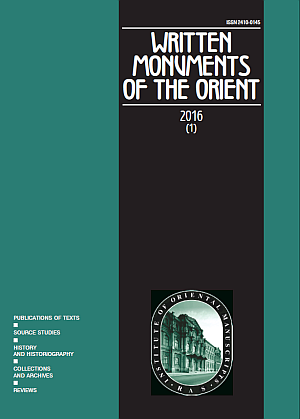Shimon Yakerson. Ozar Sepharad - Sefardskaia sokrovishchnitsa. Sefardskaia kniga X-XV vv. Ot rukopisnoi k pechatnoi traditsii. [Ozar Sepharad: Sephardic treasury. Sephardic Books from the Tenth to the Fifteenth Century. From Manuscripts to Printed Books] - St. Petersburg: Filologicheskii fakul’tet SPb. gosudarstvennogo universiteta, 2015. - 127 pp
- Authors: Kizilov M.
- Issue: Vol 2, No 1 (2016)
- Pages: 111-112
- Section: Articles
- URL: https://journals.eco-vector.com/2410-0145/article/view/25787
- DOI: https://doi.org/10.17816/wmo25787-
- ID: 25787
Cite item
Full Text
Abstract
Abstract
Full Text
Shimon Yakerson. Ozar Sepharad - Sefardskaia sokrovishchnitsa. Sefardskaia kniga X-XV vv. Ot rukopisnoi k pechatnoi traditsii. [Ozar Sepharad: Sephardic treasury. Sephardic Books from the Tenth to the Fifteenth Century. From Manuscripts to Printed Books] - St. Petersburg: Filologicheskii fakul’tet SPb. gosudarstvennogo universiteta , 2015. - 127 pp. ISBN 978-5-8465-1461-4 Written by the well-known specialist in Hebrew paleography and codicology, the book represents at the same time a serious academic study, manual of Sephardic Hebrew paleography, and short paleographic chrestomathy. The book starts with the survey of the history of Sephardic Jewry from the time of Visigothic Spain (the fifth century A.D.) and until the expulsion of 1496 (pp. 11-17). This survey serves as the introduction to the analysis of the Sephardic manuscript and printed book from the 10th to the 15th cc. (pp. 18-22). Yakerson calls the whole manuscript heritage of Sephardic Jews by the Hebrew term moreshet Sepharad (“Sephardic heritage”) and estimates that Sephardic manuscripts constitute about 22% of all medieval Jewish manuscripts; 35% of all medieval Jewish manuscripts were written with Sephardic handwriting. This is the largest group of all dated Jewish manuscripts registered in Sfar-Data database (p. 22). The author mentioned the fact that medieval Jewish authors, unfortunately, did not leave any treatises or instructions regarding the art of calligraphy (a short note of Judah Ibn Tibbon being perhaps the only exception from this rule; p. 28). As a result, modern scholars have to identify the main types of Hebrew scripts and understand other aspects related to production of Jewish books and manuscripts by themselves. As well as other paleographers, Yakerson distinguishes three main types of Sephardic scripts: square (ketav meruba), semi-cursive (ketav beinoni), and cursive (ketav rehut; pp. 23-28). On the basis of the comprehensive analysis of Sephardic incunabula Yakerson comes to the conclusion that eleven printing houses of Italy, Spain, Portugal and Turkey functioned in eight cities; 27 types of fonts were employed by Sephardic printers of the period. All of them copied variations of square and semi-cursive scripts (pp. 31-32). One can find the table with the complete list of cities and names of printers with exact characterization of specificity of the fonts and ligatures used by them (p. 32). The most important font, which combined qualities of two main types of Sephardic handwriting (square and semicursive), was invented by the famous Italian Jewish printers, the Soncino family (pp. 33-34). Important part of the book represents the codicological characterization of Sephardic manuscripts and incunabula which i.a. discusses the questions of who and why wrote manuscripts and how the date was usually expressed (pp. 35-40). The “Paleographic chrestomathy” subsection of the book (pp. 41-99) is based largely on virtually unknown manuscripts from Russian archival collections. The reader of the book can use it as a self-study manual of Sephardic scripts (the author provides both the facsimile of a given manuscript folio together with transcription of its text in square Hebrew characters). The earliest manuscript used in the study dates back to 1225 (the copy of the Tanakh from Tlemsen in Alger) while the latest - to 1492 (the list of the books of Suleiman ha-Cohen). To give samples of Sephardic printing culture, Yakerson also provides examples of Sephardic incunabula fonts. The book for the first time provides a complete list of Sephardic incunabula in academic Russian transcription (pp. 100-105). The essential bibliography (pp. 106- 108) and typology of the handwritten letters of the Hebrew alphabet (pp. 110-112) helps to continue further study of Sephardic Hebrew paleography. The book is a must for anyone interested in the study of Sephardic printed books and manuscripts. Mikhail Kizilov
About the authors
Mikhail Kizilov
Author for correspondence.
Email: mikhail.kizilov@gmail.com
Russian Federation
References
- Shimon Yakerson. Ozar Sepharad - Sefardskaia sokrovishchnitsa. Sefardskaia kniga X-XV vv. Ot rukopisnoi k pechatnoi traditsii. [Ozar Sepharad: Sephardic treasury. Sephardic Books from the Tenth to the Fifteenth Century. From Manuscripts to Printed Books] - St. Petersburg: Filologicheskii fakul’tet SPb. gosudarstvennogo universiteta , 2015. - 127 pp. ISBN 978-5-8465-1461-4
Supplementary files








